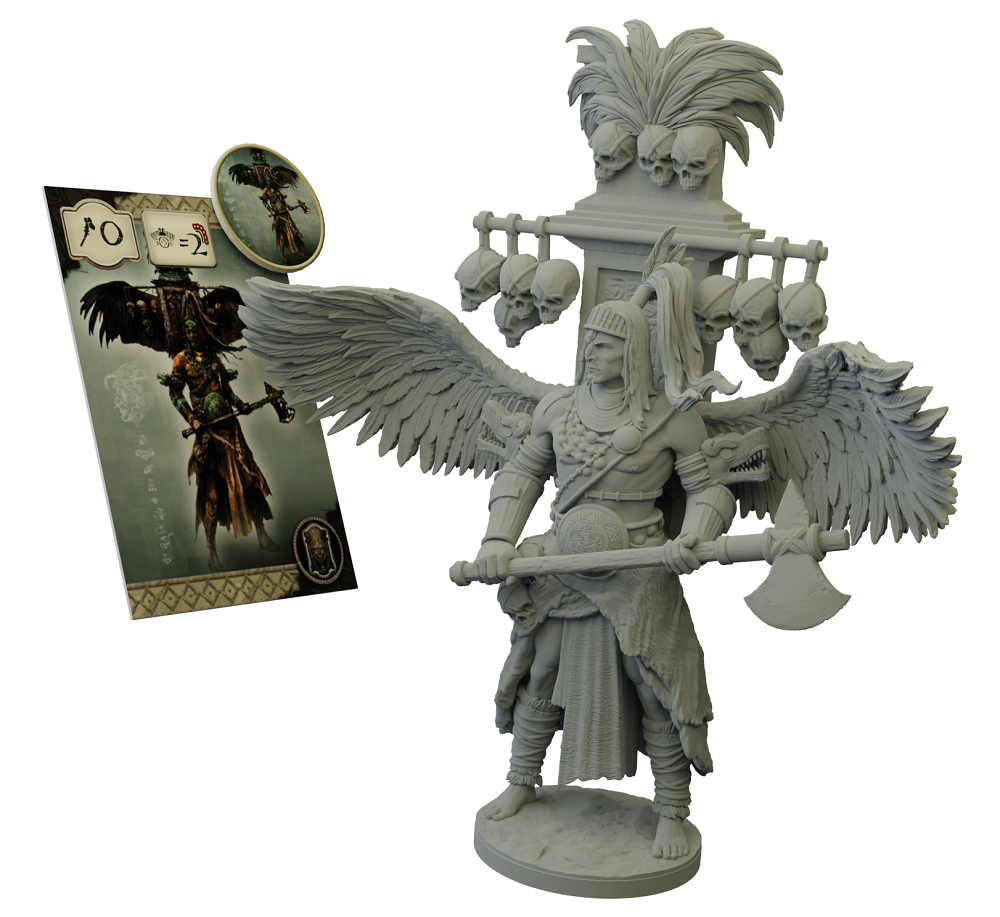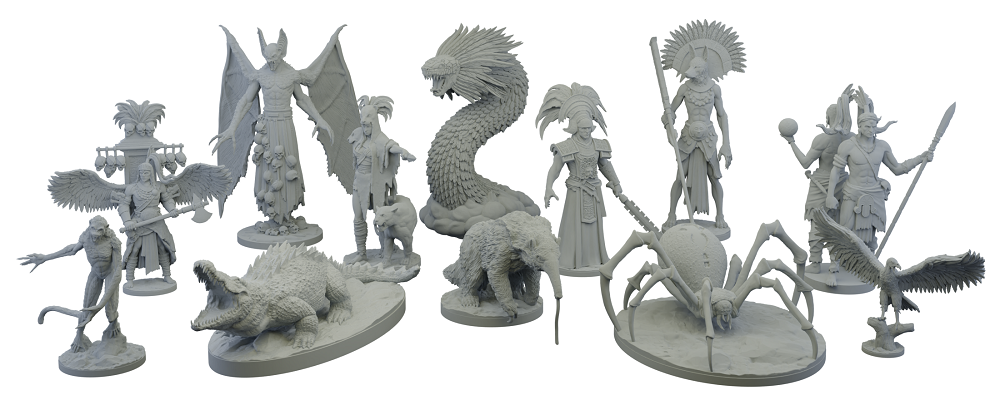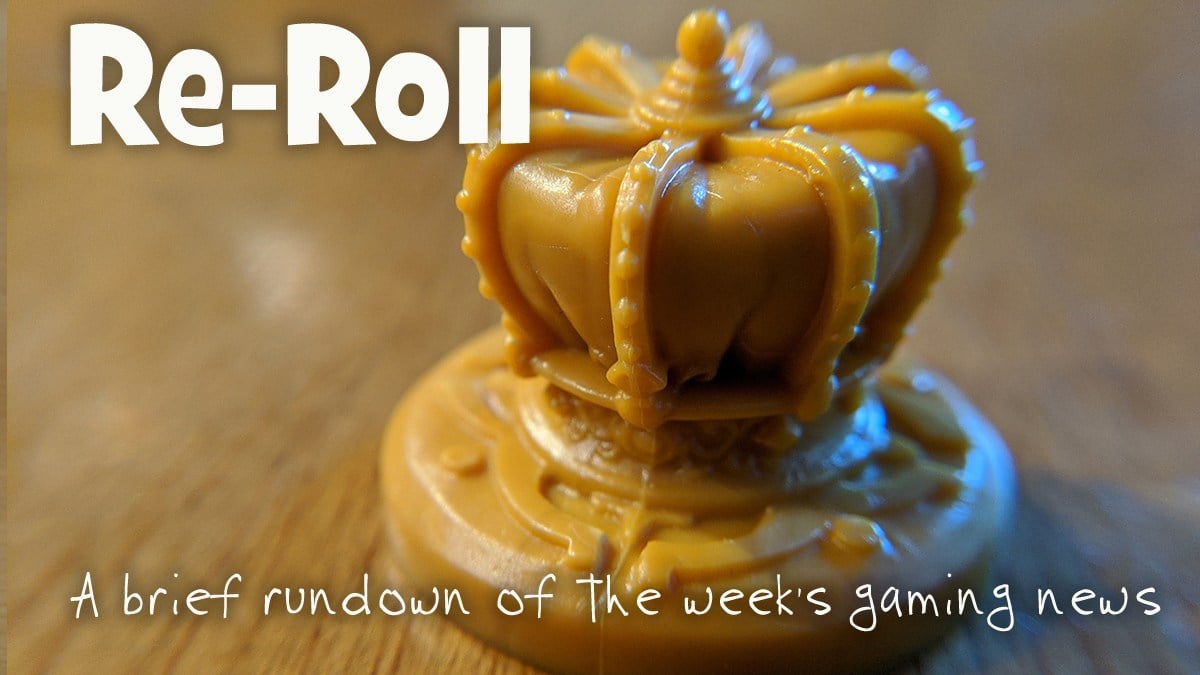As the leader of your clan, you must fight against other clans in order to assure your people’s safety from the wrath of the gods. Take prisoners and sacrifice them throughout the four seasons to become the most faithful and loyal servant. In Yucatan, you are your people’s last hope.
What Is Yucatan?
Yucatan is a confrontation game for 2-4 players, ages 14 and up, and takes about 60 minutes to play. It’s currently seeking funding on Kickstarter, with a pledge level of $80 for a copy of the game. Yucatan was designed by Guillaume Montiage and published by Matagot Editions, with illustrations by Karl Fitzgerald.
New to Kickstarter? Check out our crowdfunding primer.
Yucatan Components
Note: My review is based on a prototype copy, so it is subject to change and may not reflect final component quality.
- 1 Pyramid with Calendar on its top
- 1 Round board representing the Yucatan Jungle and its 3 Central Cities
- 40 Corn tokens
- 30 Jade tokens
- 1 First Player token
- 9 Summoning tiles
- 9 Summoning miniatures
- 60 Unit miniatures
- 1 Evolution board
- 4 City board
- 8 Troop Leader figurines
- 4 City Leader figurine
- 12 Building Action token
- 12 Leader Action token
- 4 Score marker
- 4 Sacrifice marker
- 12 Level markers
- 20 Battle cards
- 8 Timer tokens
- 48 Building tiles
- 24 Ability tiles
- 16 Advisor tokens

The pyramid is used to show players’ favor with the gods and provided bonuses as their city leaders climb up it. The calendar also keeps track of rounds.

Corn and jade represent the currency used during the game. Other tokens keep track of abilities, victory points, and act as timers for summonings.

Players can summon creatures to help support their troops in battle.

Each player has their own city board and leaders in their clan’s color as well as their own battle cards.

Battle cards are used during battles between troops. They all contain an axe value and possible bonuses.
How to Play Yucatan
You can download a copy of the rulebook here.
The Goal
The goal of the game is to score the most victory points by sacrificing prisoners and resources during the four sacrifice phases.
Setup
Start off by placing the pyramid, the round board and the evolution table board in the center of the play area. Create the supply by placing all the corn tokens, the jade tokens and the units next to the calendar. Randomly select a first player and give them the first player token. Each player then picks and color and gets all of the components in their color including a city board, a city leader figure, two troop leader figures, a timer token, sets of building, troop ability, counselor, and city leader tiles, a set of sacrifice tokens, three building action tokens, three leader action tokens, and five battle cards. Give each player 5 corn tokens and 2 jade tokens. Players place the score and sacrifice markers in their color on the zero space on the score track. They then place a level marker in the ‘Level 1’ space in each column of the evolution table.
Now each player secretly places one level 1 building on their city board. Next they secretly choose two level 0 counselor tiles showing abilities and secretly assign them to their two troop leaders on the city board. Put the unchosen tiles back in the box. They then chose one special ability for their city leader on the city board and put the rest in the box. Players take a unit from the supply and put it in their reserve as a prisoner. Then players place 2 troops in the jungle on the board. Each troop consists of a troop leader and 3 units from the supply. Finally each player places their city leader figure at the foot of the pyramid.

Gameplay
Yucatan is played over the course of four rounds. Each round is divided into 3 phases: Action, Sacrifice, and Revolution. Let’s take a look at each phase in turn.
Action Phase
The action phase is divided into three turns. At the start of the phase, the first player becomes the active player. They then play one building action token and one leader action token by placing these tokens in front of one of their buildings and one of their leaders on their city board. These can be activated in any order, but only one leader and one building can be activated in a single turn. Once the first player has completed their turn, then the player to the left goes next. This continues until all players have completed 3 turns and no one has action tokens left.
Each player has five different types of buildings: construction site, military school, barracks, temple, and granary. All buildings start the game at level 0. The construction site allows you to build new buildings in your city. You can build 3 levels of each building, but in order to build a level 2 or level 3 building, you must have reached level 2 or 3 on the construction site column of the evolution table respectively. Players can build any level of building as long as they have the resources and the requisite level on the evolution table. Higher levels of buildings offer better actions. The military school allows you to acquire an ability and add it to one of you troop leaders. There are three levels of abilities and you can only acquire abilities if you have reached that level on the ability column on the evolution table. The barracks allows you to add units to a troop up to the number shown on the barracks tile. The temple allows you to assign a summoning to one of your troops or to make a summoning already tied to a troop last more rounds. To do this, take the corresponding summoning tile and place it on your city board in the space for one of your troops who does not already have a summoning tile. Then place the summoning figure with that troop in play on the board. You can only summon a level 2 or 3 summoning if you have reached those levels for the summoning column of the evolution table. The granary is the only building that does not have higher levels. It is used to gain corn.
When activating a city leader, you choose to gain 2 corn, gain 1 jade, or spend 1 jade to gain a special battle card. You may also activate the special ability of your city leader. When you activate a troop leader, you can move its troop (the leader and all the units in the troop). Spend 1 corn to move a troop from a central city into the jungle or vice-versa. Movement ends when a troop enters a central city. If there is no opposing troop in that city, you activate the central city and gain 1 jade as well as all the jade in that city. However, if there is an opposing troop, you resolve a battle between the two troops. There are a couple restrictions to movement. You cannot move a troop into a city containing another of your troops and you can’t go back to the place from which your troop came. When activating a central city, the player may resolve one of the actions in the column for the current round or previous rounds. For example, if it is round 2, the player can choose an action from either the first or second columns on the central city table.
During a battle, the player who triggered the battle is the attacker and the opponent is the defender. At the start of a battle, each player secretly chooses one of their battle cards and then reveal them simultaneously. The players then add up the axe value on their battle card, the axe value of their troop (each leader and unit provide 1 axe), the potential axe value of that troop’s abilities, and the potential axe value of the summoning tied to that troop. The player with the highest total value is the winner and takes one unit of the opposing troop as a prisoner. If the attacker wins, they move the defender’s troop into the jungle and then activates that central city. If the defender wins, the attacker’s troop is moved into the jungle. Each player then applies potential prisoner bonuses from their battle card, abilities, or summoning and then remove their battle cards from play unless the card allows them to keep it. In case of a draw, the defender’s troop moves to the jungle and the attacker may activate the central city. Prisoners are not taken from either troop, but prisoner bonuses are collected. Depending on prisoner bonuses, a player may be able to capture all of the members of the opposing troop and wipe it out. If this happens, that player gains 1 victory point and takes a unit from the supply as a prisoner. The troop leader is returned to the owner and the wiped out troop may be replaced in the jungle with the troop leader and as many units as allowed by their barracks.

Sacrifice Phase
Once the action phase is complete, each player secretly takes as many prisoners from their prison that they wish to sacrifice and may add resources as well. They then reveal their sacrifices simultaneously and sum up their sacrifice points or SP. The amount of SP for prisoners depends on the round. Each prisoner in the first round is worth 3 SP, 2 SP in the rounds 2 and 3, and 1 SP in round 4. They also get 1 SP for each set of 2 jade or each set of 4 corn that are sacrificed. Players move their sacrifice marker on the sacrifice track accordingly. The sacrificed elements are returned to the supply and players gain as many victory points as their SP for the round. The player who scored the most SP moves their city leader up one step on the pyramid and collects the rewards for that step. Finally, in turn order, each player whos SP for the current round is higher than their SP from the previous round move one of the markers on the evolution table up a level. If a player gets at least 1 SP for the first round, they can increase their level on the evolution table by one in two different columns.
Revolution Phase
After players complete the sacrifice phase, summonings whose timer token corresponds to the current round are removed from the player and returned to the supply. Each of the three central cities evolve allowing for more available actions in the next round. Place 1 jade on every central city that contains no troops. Finally, the first player passes the first player token to another player of their choice and start a new round. If this is the fourth round, then the end game is resolved instead.
Game End
The game ends when round 4 has been fully completed and the end game is resolved. Each player who has their evolution marker on the last row of the evolution table choose one final bonus among summoning, ability, or building bonuses. If they choose the summoning bonus, then they get 2 VP per summoning level of their summonings still in play that have not been returned at the end of the round. The ability bonus provides 1 VP per ability level they own. The building bonus gives 1 VP per building level they own. They also score 1 VP for each set of 2 jade and 1 VP for each set of 4 corn. The player with the most VP is the winner. In case of a tie, the player ahead on the pyramid is the winner.
Why You Should Play Yucatan

Yucatan is designed by the same team who create Kemet. The theme is unique as well as interesting. The components also look great, especially the summoning miniatures. I like how the game is limited to four rounds and lasts about an hour. This forces players to be aggressive if they want to capture prisoners for sacrifices and really think about how they want to spend their actions during the turns since there is not enough time to do everything. The rules are somewhat complex and the game can take a bit more effort to teach to other players. However, the best way to learn the game is just to play it. The designers have done a great job combining various mechanics into a single game. While you are building a tableau, you also have to choose between building up your troops or increasing your resources while keeping in mind that you will need to capture prisoners for your sacrifices. All of these mechanics come together neatly and fit extremely well with the theme. I recommend Yucatan as a fun yet challenging game that makes a great addition to game collections.
For more information or to make a pledge, visit the Yucatan Kickstarter page!
Click here to see all our tabletop game reviews.
![]() To subscribe to GeekDad’s tabletop gaming coverage, please copy this link and add it to your RSS reader.
To subscribe to GeekDad’s tabletop gaming coverage, please copy this link and add it to your RSS reader.
Disclosure: GeekDad received a copy of this game for review purposes.





